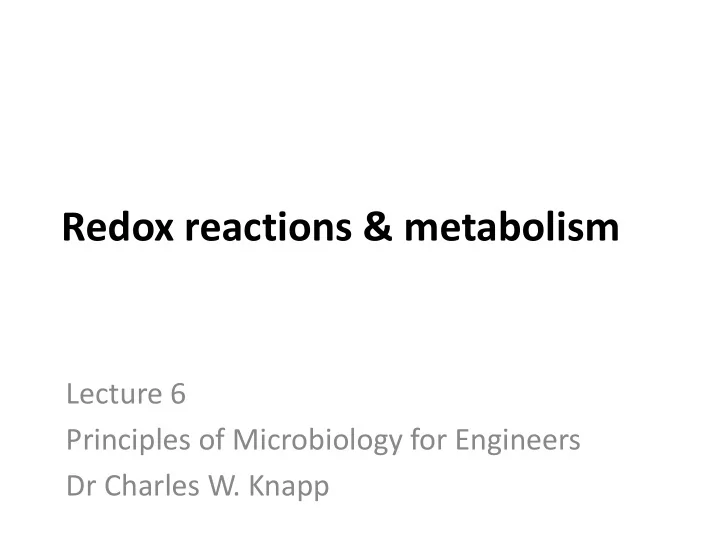

Redox reactions & metabolism Lecture 6 Principles of Microbiology for Engineers Dr Charles W. Knapp
Redox • Oxidation – reduction reactions • All chemical reactions where an atom has its oxidative state changed • i.e., CO 2 versus CH 2 O versus CH 4 ( +4 ) + 2(-2) ( 0 )+(+2)+(-2) ( -4 )(+4)
Reduction reactions • Is the gain of electron, or decrease in oxidative state • Oxidant + electrons product (e.g.,) photosynthesis (in respects to C): 6CO 2 + 6H 2 O + light C 6 H 12 O 6 + 6O 2
Oxidation reactions • Is the loss of electrons, or increase in oxidative state • Reductant product + electons (e.g.,) respiration (in respects to C): C 6 H 12 O 6 + 6O 2 6CO 2 + 6H 2 O
In microbiology… • Reduced chemicals represent “energy source” – e.g., carbohydrates, S 2- , NH 3 , Fe +2 • Oxidised chemicals represent “electron acceptors” – e.g., O 2 , SO 4 2- , NO 3 - , Fe +3
Half reactions • In fact, each reaction represent a “half reaction” (either oxidation or reduction). • Reduction potential (E’ 0 ) can be determined.
Redox • Reduction oxidation potential (redox) is a measure of the ability of the environment to supply or receive electrons. • The redox state of a solution is defined by the number of free electrons present in the solution, in a fashion similar to pH
Redox
Redox Gao, et al. (2003) California Agriculture 57: 55
Sabine Grunwald, Uni. Florida
Respiration • Oxygen (O 2 ) as the electron acceptor • [CH 2 O] + O 2 CO 2 + H 2 O (+ ~5 ATP) • Can generally use a great variety of carbon substrates • Different species are often specialised in terms of C-substrate use
Anaerobic respiration • Electron transport is analogous to aerobes, but use different redox potentials • Nitrate – most common form of anaerobic respiration (denitrification)
Anaerobic respiration - + 4H + 5 CO 2 + N 2 + 7H 2 O 5[CH 2 O] + 4NO 3 • Almost as energetically favourable as aerobic respiration • Significance to environmental engineering: – N removal from systems – Production of greenhouse gases (N 2 O, NO)
Electron acceptors • Metal oxides – Abundant in soils and sediments of terrestrial origin – Iron oxides – Manganese oxides CH 3 COO - + 8 Fe 3+ + 4H 2 O 2HCO 3 - + 8Fe 2+ + 9H +
Electron acceptors • Metal oxides – More limited range of C-substrates (e.g., no sugars) • Acetate, lactate (simple organic acids) • Simple alcohols • Simple hydrocarbons • H 2 – Can use a great variety of metals & metalloids • Cu, As, Mo, V, Cr, Se, Co
Electron acceptors • Metal oxides – Significance: • Metal solubility changes with oxidation state • Fe-oxides are solids sorbs many other chemicals Its reduction can lead to solubilisation and mobility of other chemicals (e.g., phosphate, arsenic…)
Electron acceptors • Sulphates – Complete C-oxidisers – Incomplete C-oxidisers – Similar substrate conditions as metal reducers – Significance is primarily marine 80% of C-mineralisation in anaerobic sediment by sulphate-reducing bacteria
Electron acceptors • Carbon dioxide – e.g., methanogenesis – methanogens all archaea 1) CO 2 only: CO 2 + 3H 2 CH 4 + H 2 O 2) Acetoclastic: CH 3 COO - + H 2 O CH 4 + HCO 3 - (Acetogenic bacteria) - + H + CH 3 COO - + 4H 2 O 4H 2 + 2HCO 3
Electron acceptors • Fermentation – No electron-transport chain – (problem how to re-oxidise NADH?) NADH – nicotinamide adenine dinucleotide – “Internal redox reaction”
Electron acceptors • Fermentation – Lactic acid fermentation (2-3 ATP/C) ATP is generated by substrate-level phosphorylation Strict redox balance: average oxidation state of product is same as substrates Only substrates with intermediate oxidation states can be fermented Must involve pyruvate as an intermediate Only under strict anaerobic conditions
MFCGuy2010 (Wikipedia, CC BY-SA 3.0)
Recommend
More recommend